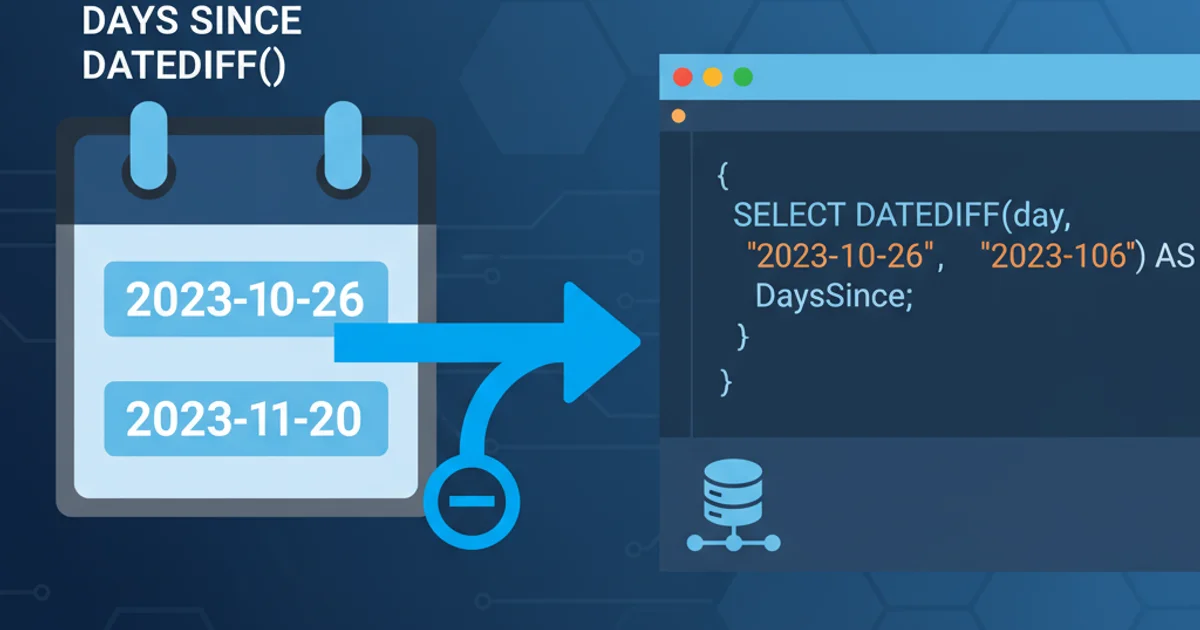SQL days since DATEDIFF()
Mastering SQL DATEDIFF(): Calculating Days Between Dates

Learn how to effectively use the SQL DATEDIFF() function to calculate the difference in days between two dates across various database systems, avoiding common pitfalls and ensuring accurate results.
Calculating the difference between two dates is a common requirement in database operations, whether you're tracking project durations, customer lifecycles, or age. The DATEDIFF() function is a powerful tool in SQL for this purpose, allowing you to determine the number of days, months, years, or other date parts between two specified dates. This article will focus specifically on calculating the difference in days, providing examples for popular database systems like SQL Server, MySQL, PostgreSQL, and Oracle.
Understanding DATEDIFF() Syntax and Behavior
The DATEDIFF() function's syntax can vary slightly between different SQL database systems, but its core purpose remains the same: to return the count of the specified datepart boundaries crossed between the two dates. When calculating days, it's crucial to understand how each system handles partial days and the order of the date arguments.
flowchart TD
A[Start Date] --> B{DATEDIFF Function Call}
B --> C{Date Part: 'day'}
C --> D[End Date]
D --> E[Result: Number of Days]
E --> F{Considerations: Inclusive/Exclusive, Time Components}Basic flow of calculating date differences using DATEDIFF().
DATEDIFF() in SQL Server
SQL Server's DATEDIFF() function is straightforward. It takes three arguments: the date part (e.g., day, month, year), the start date, and the end date. It returns an integer representing the count of the specified datepart boundaries crossed between the two dates. For example, DATEDIFF(day, '2023-01-01', '2023-01-02') returns 1, as one day boundary is crossed.
SELECT DATEDIFF(day, '2023-01-01', '2023-01-10') AS DaysDifference;
-- Result: 9
SELECT DATEDIFF(day, '2023-01-10 10:00:00', '2023-01-11 09:00:00') AS DaysDifference;
-- Result: 1 (because the day boundary between Jan 10 and Jan 11 is crossed)
Examples of DATEDIFF() in SQL Server for calculating days.
DATEDIFF() counts the number of times a date part boundary is crossed. This means DATEDIFF(day, '2023-01-01 23:59:59', '2023-01-02 00:00:01') will return 1, even though only two seconds have passed, because the day boundary was crossed.DATEDIFF() in MySQL
MySQL's DATEDIFF() function is simpler, specifically designed to calculate the difference in days. It takes two date arguments and returns the number of days between the first date and the second date. The time part of the dates is ignored. The result is expr1 - expr2 expressed as a value in days.
SELECT DATEDIFF('2023-01-10', '2023-01-01') AS DaysDifference;
-- Result: 9
SELECT DATEDIFF('2023-01-11 09:00:00', '2023-01-10 10:00:00') AS DaysDifference;
-- Result: 1 (time part is ignored, only dates are compared)
Examples of DATEDIFF() in MySQL, which specifically calculates day differences.
DATEDIFF() is unique in that it only calculates day differences. For other date parts, you would typically use TIMESTAMPDIFF() or other date functions.Calculating Days in PostgreSQL and Oracle
PostgreSQL and Oracle do not have a direct DATEDIFF() function that works identically to SQL Server or MySQL. Instead, you perform date arithmetic to get the difference, and then extract the number of days. This often involves subtracting dates and casting the result to an interval or number of days.
PostgreSQL
SELECT DATE '2023-01-10' - DATE '2023-01-01' AS DaysDifference; -- Result: 9 (days)
SELECT EXTRACT(DAY FROM ('2023-01-10 10:00:00'::timestamp - '2023-01-01 09:00:00'::timestamp)) AS DaysDifference; -- This will give the day component of the interval, which might not be the total days. -- For total days, it's better to cast to date first: SELECT (DATE '2023-01-10' - DATE '2023-01-01') AS DaysDifference; -- Result: 9
Oracle
SELECT TRUNC(TO_DATE('2023-01-10', 'YYYY-MM-DD') - TO_DATE('2023-01-01', 'YYYY-MM-DD')) AS DaysDifference FROM DUAL; -- Result: 9
SELECT TRUNC(SYSDATE - (SYSDATE - 5)) AS DaysDifference FROM DUAL; -- Result: 5
-- To handle timestamps and get full days: SELECT TRUNC(CAST(TIMESTAMP '2023-01-10 10:00:00' AS DATE) - CAST(TIMESTAMP '2023-01-01 09:00:00' AS DATE)) AS DaysDifference FROM DUAL; -- Result: 9
INTERVAL (PostgreSQL) or a NUMBER representing fractional days (Oracle). Use DATE casting or TRUNC() to ensure you're getting whole day differences.Common Pitfalls and Best Practices
While DATEDIFF() and similar functions are powerful, there are common issues to be aware of:
- Order of Arguments: Always double-check the order of your start and end dates. Swapping them will result in a negative number.
- Time Components: Understand how your specific database handles time components. Some ignore them for day calculations, while others consider them when crossing date boundaries.
- Inclusive vs. Exclusive:
DATEDIFF()typically calculates the number of boundaries crossed, which can sometimes lead to off-by-one errors if you expect an inclusive count of days. For example, the difference between '2023-01-01' and '2023-01-01' is 0, but if you need to count the start day itself, you might need to add 1. - Performance: For very large datasets, complex date calculations can impact performance. Consider indexing date columns if you frequently filter or sort by date differences.
1. Define Your Requirement
Clearly determine if you need the number of full days, or if crossing a day boundary (even by a second) counts as a full day. This will influence your function choice and potential adjustments.
2. Choose the Correct Function
Select the appropriate DATEDIFF() variant or date arithmetic method for your specific database system (SQL Server, MySQL, PostgreSQL, Oracle, etc.).
3. Test with Edge Cases
Always test your queries with dates that are the same, dates that are one day apart, and dates that cross midnight to ensure the results match your expectations.
4. Handle Time Zones (If Applicable)
If your application deals with multiple time zones, ensure your dates are converted to a common time zone before performing DATEDIFF() calculations to avoid discrepancies.